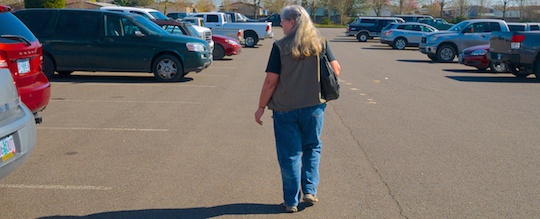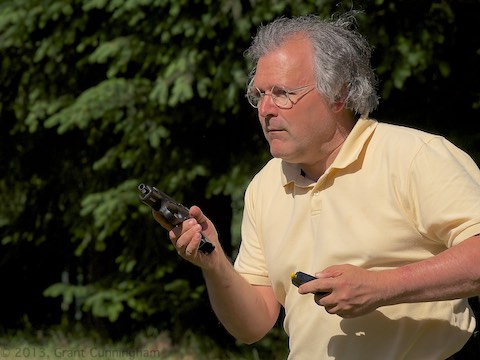
Personal safety apps: do they really keep you safer?
Sometimes I think people have a distorted view of personal security — particularly in the media!
Now I know that’s hard to believe; after all, if you can’t trust the media, who can you trust? (In case anyone doesn’t get the sarcasm in that sentence, well — it’s sarcasm!) They’ve been reporting lately on a number of new smartphone apps to help keep people safer, going so far as to label them as self-defense devices.
Are they? What do they really do to keep people safe?
Let’s start by looking at the building blocks of an effective security plan, a list which has evolved a little over the years I’ve been studying and teaching this topic:
— Detection
— Avoidance
— Deterrence
— Defense
— Reporting (which I’ve added recently)
Detection means that we would like to have skills and/or equipment in place to spot potential attackers before they actually get to us. On the street it might mean observing patterns of behavior, while at home it might mean surveillance or alarm systems to alert us to the presence of someone who shouldn’t be there.
Avoidance is the presence of mind and the pre-planning to prevent or keep away from the conflict, which can include things like de-escalation techniques (applicable in social violence incidents) and ways to keep us from exposing ourselves to dangerous situations (like not going into bad parts of town in the wee hours of the morning, or not leaving laptop computers on the front seat of our cars in the mall parking lot.)
Deterrence is all about convincing bad guys that an attack ( violent or nonviolent) would not be in their best interest, either because it won’t be profitable or they’ll be hurt. Bars on windows, for instance, tell burglars that this is a house which is going to be hard to get into and likely arouse a lot of unwanted attention if they try. On a personal basis, an alert without being confrontational posture walking down the street might convince someone that there are easier pickings to be had.
Defense is something most “gun people” would probably understand. It’s that point when we decide do something actively to the other person to keep him from hurting us; this can range from pepper spray to lethal force options. Defense is a response, something we do at the point we realize that we are being attacked.
Finally, reporting means communicating to the authorities that we’ve been attacked and need help — or that we suspect we’re going to be attacked.
The list is not meant as any sort of workflow or incident checklist, but rather are the things we should understand and be able to do if we’re going to truly protect ourselves and our families from harm. (They apply to more than criminal attacks; if you think about it, these building blocks apply to medical emergencies and fires, too.)
How do these new personal safety apps, like the one in this article, fit into that personal security matrix?
As far as detection, as near as I can tell it does nothing; in fact, by having the user interact with the app they may actually reduce the ability of the person to gather information about her surroundings, information that can go a long way to that second item, avoidance.
For instance, if a young lady (the obvious market for this app) is prevented — either because of the interactivity the app demands or from an undeserved feeling of invincibility — from doing things like looking under her car or in the back seat for an intruder, she may actually be increasing her risk of being attacked. The more places a bad guy can hide in the transitional space between the safety of a building and that of a locked car, the more effort the defender has to make in observance.
As I’ve said before, we only have so much attention or sensory capability; we can’t magically expand it, we can only choose how we’re going to apply it in any given situation. Having an app that interferes with that process (both the decision on how to allocate that finite ability and in the conscious act of actually doing so) makes us less safe, not more.
Avoidance? Just like with detection, it’s hard to explain how a personal safety app like this would help anyone avoid anything. It’s not going to tell the user when entering a transitional area is a bad idea, and it’s not going to tell the person when it’s time to run away (still a valid defensive strategy in some instances.)
Deterrence? Well, I suppose one could argue the alarm function might be a deterrent in some cases. However, I don’t know about you but I find the speaker on my phone to be barely usable for hands-free phone conversations in a moving vehicle; the road noise usually plays havoc with hearing, even with the volume turned all the way up. How loud would an alarm be, and would it really summon anyone from any distance? I have my doubts, and so I’m calling this a long shot.
Defense? Only if the user throws the phone at the attacker!
The only place where this kind of app would have any real value is in the reporting aspect. I hate to sound morbid, but in reality it simply gives the police a place to look for a body. Attacks take place in a matter of seconds; by the time this app realizes (through its sensor monitoring) that something was amiss and waited the requisite time for the user to press the “I’m OK” button before actually alerting someone, the attack could well be over. Factor in the time delay in summoning the authorities, and the low priority any alarm call is going to be assigned by dispatch — well, we’re back to telling the police where to look for the corpse. At best.
It may give the user confidence, and there are those who would argue that in itself is valuable. Unfortunately it’s a false confidence, and false confidence often tempts people to go to places and do things that they wouldn’t ordinarily do because they believe the magic app will protect them. That’s an increase in risk, not a decrease.
Yes, I’m sure it will make some young people “feel better”. I’d rather, however, that they feel better because they have the skills and knowledge they need to know how to prevent an incident and how respond to an attack if they need to. That’s what will actually keep them safe!
– Grant Cunningham
- Posted by Grant Cunningham
- On September 17, 2015



